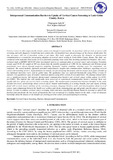| dc.contributor.author | Chepngeno, Judy B. | |
| dc.contributor.author | Kiptoo, Michael | |
| dc.date.accessioned | 2023-12-07T15:08:44Z | |
| dc.date.available | 2023-12-07T15:08:44Z | |
| dc.date.issued | 2023-11-24 | |
| dc.identifier.uri | https://doi.org/10.51867/ajernet.4.2.127 | |
| dc.identifier.uri | https://ajernet.net/ojs/index.php/ajernet/article/view/228 | |
| dc.identifier.uri | http://ir-library.mmust.ac.ke:8080/xmlui/handle/123456789/2472 | |
| dc.description.abstract | ervical cancer is still a major health risk for women even though it is preventable. Its prevalence indicates lack of success with screening and early diagnosis. Considering most women who visit hospitals have advanced stages of the disease, deaths from this type of cancer will rise if immediate action is not taken. This study sought to determine the obstacles to interpersonal communication as a means for encouraging adoption of cervical cancer testing in Uasin Gishu County, Kenya. The study was conducted at the maternal child-health services and family planning clinic at the Moi Teaching and Referral Hospital. This cross-sectional study at MTRH's MCH-FP clinic investigated barriers to communication on cervical cancer and screening. Targeting women aged 18-65, the sample of 308 was drawn from the monthly population of 1,000. Six key informants and 20 focus group participants were chosen through purposive sampling. Systematic random sampling, selecting every 3rd respondent, was employed. The mixed methods approach provided comprehensive insights into communication challenges regarding cervical cancer and screening services. A questionnaire for women, two focused group discussions with ten women each, and a schedule of key informant interviews were used to gather data. The qualitative data was analysed thematically using NVivo version 12 software. For quantitative data, descriptive statistical analysis using SPSS version 29 was undertaken. The findings showed there was a significant inverse link between interpersonal communication barriers and cervical cancer testing uptake (r=-0.561, p=<0.001). This implied that with significantly more perceived or experienced communication barriers reported, there was significantly less uptake of cervical cancer screening uptake. The interpersonal communication barriers identified in the study included low levels of knowledge about cervical cancer, limited understanding of screening benefits, fear and stigma of being found with cervical cancer and fear of the screening procedure, language barriers, myths and misconceptions about cervical cancer, poor relationship between the health care workers and clients stemming from age and gender and the women’s religious beliefs. In order to enhance cervical cancer screening, better and more targeted information should be provided to address the barriers and specifically the low levels of knowledge that was recognized as a leading barrier in the study. A lack of adequate knowledge about the disease or the benefits of screening prevents women from participating in screening. | en_US |
| dc.language.iso | en | en_US |
| dc.publisher | AFRICAN JOURNAL OF EMPIRICAL RESEARCH | en_US |
| dc.subject | Interpersonal, Communication, Barriers, Uptake, Cervical, Cancer, Screening, County, | en_US |
| dc.title | Interpersonal Communication Barriers to Uptake of Cervical Cancer Screening in Uasin Gishu County, Kenya | en_US |
| dc.type | Article | en_US |

